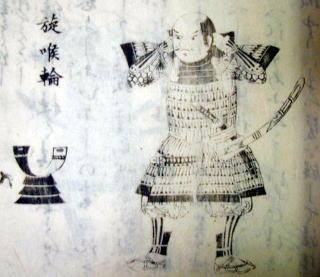Yoroi
The teacher of Masaki-ryu Nakajima-ha Soke Nakajima Michio-sensei was Nawa Yumio-sensei, whose ancestors were senior retainers to the ruling Toda family of the Ogaki clan. Nawa-sensei was intimately familiar not only with kusarijutsu and juttejutsu, but with Japanese warrior culture in general, and not only instructed in the martial arts, but also served as a period culture advisor for movies, TV programs, and theatre. Part of Nawa-sensei’s teachings were regarding the correct donning of samurai armor (katchū). After the Warring States period, many samurai in the comparatively peaceful Edo Period were far removed from combat, and the fact they were unclear as to even how to wear armor is clear from the great number of instructional books written on the donning of armor in the Edo period. One representative work is known as “Tanki Yoryaku (the equipage required of individual warriors riding into battle)”, with the photos from this post taken from this work. “Tanki Yoryaku” introduces standard methods of donning armor (katchū chakuyoho) when normally preparing for battle. This method requires the person donning the armor as well as an assistant; however, samurai also needed a working familiarity with donning armor rapidly by themselves, known as “katchū sochakuho”. The work “Meiryo Kohan” says “There are various rapid armor donning methods in other books that describe how to do this; however, if you feel an enemy may launch a night attack and are concerned about this, you should simply keep your armor on and lean against something to sleep. Nothing is quicker than this in terms of donning armor”. Nawa-sensei explained that this was nonsensical and inexperienced, and that no matter how used to wearing armor the wearer might be, that sleeping in armor for several days would fatigue the wearer and make sleeping difficult. To prepare to don armor in an emergency, a thick bamboo pole would be hung from the ceiling with the armor’s do (chest plates) with kote (arm guards) attached strung up from it using two cords. The do (chest plate) would be set to the shoulder height of the wearer, and set to enable them to rapidly don this central normally time-consuming item by slipping into it from below and then pulling the cords out. This is merely one example of the considerations for rapid armor donning, but can be said to be an important part of Japanese warrior culture.
正木流中島派宗家・中島通夫先生の師匠・名和弓雄先生の先祖は大垣戸田家家臣でした。鎖十手術などは勿論、武家文化全般に精通し、武術指南だけでは なく、映画・テレビ・舞台等の時代考証家としても勤められました。 その教えの一部には甲冑着用法があります。戦国時代を終え、比較的に平和な江戸時代では、侍の多くは実戦から遠ざかり、甲冑着用の心得も弁えていなかった 証拠に、江戸時代に大量に印刷された甲冑着用指南本があります。 その代表作には写真の『単騎要略』があり、中に平常時の定式着用法が紹介されています。甲冑を着用する本人と、もう一人付け人が必要な着方ですが、武士は 非常時には一人で素早く着られる方法、いわゆる「早着」作法も不可欠でした。 『明良洪範(めいりょうこうはん)』には「いろいろ早着の法などいうものがあって、仕掛け様を書いているが、もし、敵が夜討ちを仕掛けてくる気配があって 心配であれば、具足を着用したまま何かに寄りかかって眠るがよい。これ以上に早い、具足早着の法はない」と言っていますが、名和先生はこれが論外で、いく ら甲冑を着慣れていても、着用のままでは数日就寝すれば、身体も疲労し、寝苦しいと主張しました。 非常時の着用に備えて、天井より太い孟宗竹の竿を吊るして、両籠手を左右の肩に取り付けた胴中をこの太い竹竿に二本の紐で吊るし上げたと。胴は着用する人 の肩の高さに合わせて、下から潜って入ったら紐を抜いて素早く着られるように設定して着用する時間の短縮をずいぶんと実現しました。これ以外にも早着の心 得がいくつもあり、これがその一例ですが、日本の大事な武家文化の一つとは言えます。








